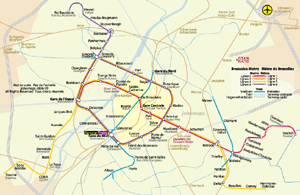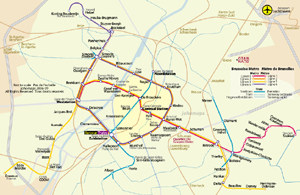|
Brussels (From Wikipedia)
Copyright owned by wikipedia.org
See
here for copyright and licensing conditions
Brussels (French: Bruxelles; Dutch: Brussel; German: Brüssel) is the capital of Belgium, the French Community of Belgium, the Flemish Community and the main seat of the European Union's institutions (and thus often considered 'The Capital of Europe').
Brussels is, first of all, a city located in the centre of Belgium and is its capital, but it sometimes also refers to the largest municipality of the Brussels-Capital Region. This municipality inside Brussels is correctly named The City of Brussels (French: Bruxelles-Ville or Ville de Bruxelles, Dutch: Stad Brussel), which is one of 19 municipalities that make up the Brussels-Capital Region (see also: Municipalities of the Brussels-Capital Region). The municipality has a population of about 140,000 while the Brussels-Capital Region has 1,018,804 inhabitants (1 January 2006). The Metropolitan area has about 2,090,000
inhabitants.
The Brussels-Capital Region is one of the three federated regions of Belgium, alongside Wallonia and the Flemish Region. Geographically and linguistically, it is a (bilingual) enclave in the (unilingual) Flemish Region. Regions are one component of Belgium's complex institutions, the three communities being the other component: the Brussels inhabitants must deal with either the French (speaking) community or the Flemish Community for matters such as culture and education.
Brussels is also the capital of both the French Community of Belgium
(Communaut?française Wallonie-Bruxelles in French) and of Flanders (Vlaanderen); all Flemish capital institutions are established here: Flemish Parliament, Flemish government and its administration (though Antwerp is considered the cultural capital of Flanders).
Two of the main institutions of the European Union - the European Commission and the Council of the European Union - have their headquarters in Brussels: the Commission in the Berlaymont building and the Council in the Justus Lipsius building facing it. The third institution, the European Parliament, also has a parliamentary chamber in Brussels in which its committee meet and some of its plenary sessions are held (the other plenary sessions are held in Strasbourg, and its administrative headquarters are in Luxembourg).
Brussels is also the political seat of NATO, the North Atlantic Treaty Organisation, the Western European Union (WEU) and EUROCONTROL, the European Organisation for the Safety of Air Navigation.
Due to this, some countries have three ambassadors present in Brussels:
the normal bi-lateral ambassador, the EU-ambassador, and finally the
NATO-ambassador.
The "language border" divides Belgium into a northern, Dutch-speaking region, and a southern, French-speaking region. Although the real language border and the official one are largely identical, there are bilingual pockets on both sides with, in certain cases, no specific linguistic rights for the population speaking the other language. The Brussels-Capital Region is officially bilingual, while the majority of its residents speak French (see the linguistic history of Brussels in this article: linguistic situation section).
The highest building in Brussels is the South Tower (150 m); the most famous probably the Atomium, which is a remnant from the 1958 World Exposition.
[Read
full article]
|


